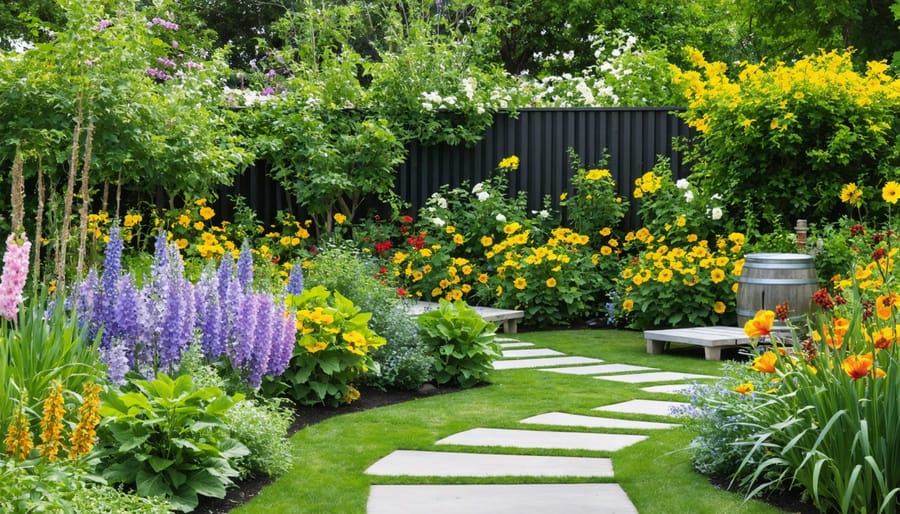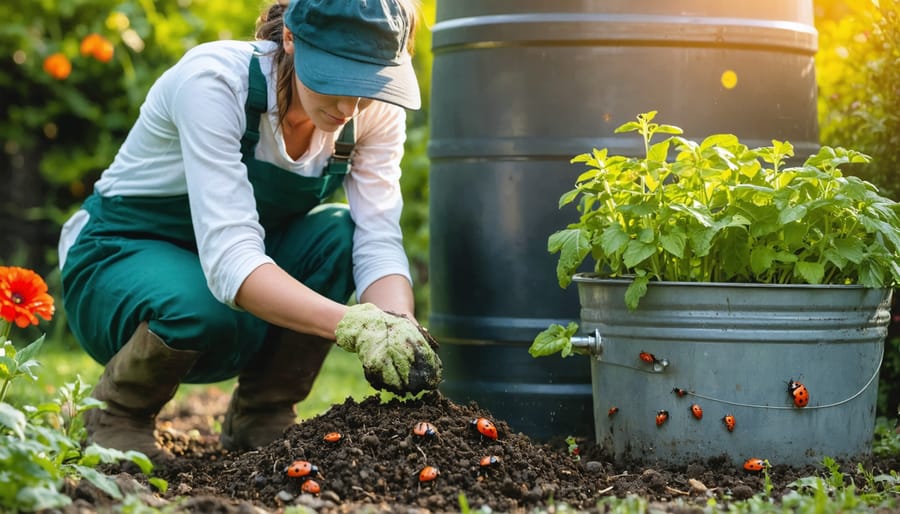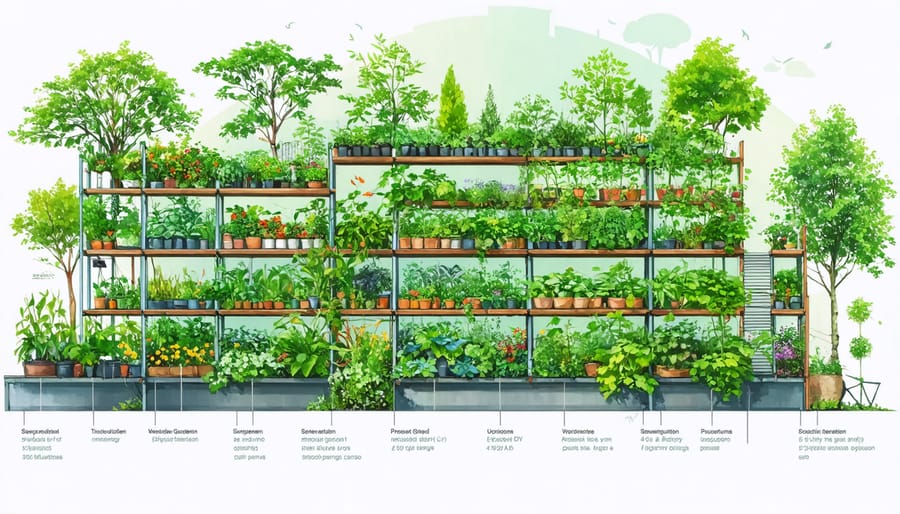Transform your backyard into a resilient oasis by learning to climate-proof your garden against extreme weather patterns. Design smart microclimates using strategic plant placement and windbreaks to protect sensitive species. Select drought-tolerant native plants that adapt naturally to local conditions while supporting vital pollinators. Build healthy, water-retentive soil through organic matter enrichment and proper mulching techniques that regulate soil temperature and moisture levels.
As unpredictable weather becomes our new normal, climate gardens represent more than just sustainable landscaping—they’re living laboratories that demonstrate nature’s remarkable resilience. By incorporating weather-hardy species, water-wise irrigation systems, and adaptive management practices, your garden can thrive despite climate challenges while contributing to local ecosystem health.
This practical guide will walk you through creating a garden that not only survives but flourishes in changing conditions, whether you’re a seasoned gardener or just starting your green journey. Let’s explore how thoughtful design choices and smart plant selection can help you build a beautiful, climate-resilient outdoor space that brings joy for years to come.
What Makes a Garden Climate-Ready?
Climate-Smart Design Principles
When designing a climate-smart garden, thoughtful layout planning is essential for long-term success. Start by observing your garden’s natural patterns – where water collects, which areas receive the most sun, and how wind moves through the space. Position taller plants and structures on the north side to avoid casting shadows on sun-loving plants, and create windbreaks using dense shrubs or permeable fencing to protect delicate plants.
Incorporate water-smart features like swales and rain gardens to capture and direct rainwater where it’s needed most. Group plants with similar water needs together to optimize irrigation efficiency. Consider raised beds with good drainage for areas prone to flooding, and create microclimates using rocks, walls, or other heat-absorbing materials to protect sensitive plants during temperature extremes.
Maximize space efficiency through vertical gardening techniques and implement wide paths made from permeable materials to prevent soil erosion and allow proper drainage. Remember to leave room for future climate adaptations – flexibility in your design will help your garden evolve with changing weather patterns.
The key is creating a garden that works with nature rather than against it, making the most of your specific site conditions while preparing for weather uncertainties ahead.

Water Management Solutions
In a climate-conscious garden, smart water management is essential for both sustainability and plant health. Implementing water-efficient garden design starts with simple yet effective strategies that make every drop count.
Consider installing a rainwater harvesting system using barrels or tanks to collect precipitation from your roof. This free resource can significantly reduce your reliance on municipal water supplies. Drip irrigation systems deliver water directly to plant roots, minimizing waste through evaporation and ensuring your plants receive consistent moisture.
Mulching is another powerful tool in your water conservation arsenal. A 2-3 inch layer of organic mulch helps retain soil moisture, reduce evaporation, and suppress thirsty weeds. Consider materials like straw, wood chips, or leaf mold, which break down over time to enrich your soil.
Group plants with similar water needs together, creating hydrozones that make irrigation more efficient. Installing moisture sensors or smart irrigation controllers can help you water only when necessary, preventing both under and over-watering. Remember, deep, infrequent watering encourages stronger root systems than frequent, shallow watering.
Choosing Climate-Resilient Plants
Drought-Tolerant Heroes
When the heat is on and rain becomes scarce, these garden champions truly shine. Drought-tolerant plants are nature’s answer to challenging weather conditions, offering both beauty and resilience in your climate-smart garden.
Lavender stands out as a Mediterranean marvel, with its fragrant purple spikes and silver-gray foliage that thrives in sunny, dry conditions. Sedum, often called stonecrop, creates gorgeous ground cover with its succulent leaves and clusters of tiny flowers that pollinators adore.
Russian sage brings dramatic height and movement to your garden, its delicate purple blooms dancing in summer breezes while requiring minimal water. For stunning ground coverage, consider creeping thyme, which releases a delightful aroma when stepped upon and creates a living carpet that laughs in the face of drought.
Don’t overlook native options like black-eyed susans and butterfly weed, which have naturally adapted to local conditions over thousands of years. These hardy performers not only withstand dry spells but also support local wildlife and create habitat corridors.
For architectural interest, consider ornamental grasses like blue fescue or Mexican feather grass. These graceful plants add movement and texture while being incredibly low-maintenance and water-wise. Remember, these tough plants may need regular watering during their first season to establish strong roots, but once settled, they’ll reward you with years of drought-resistant beauty.
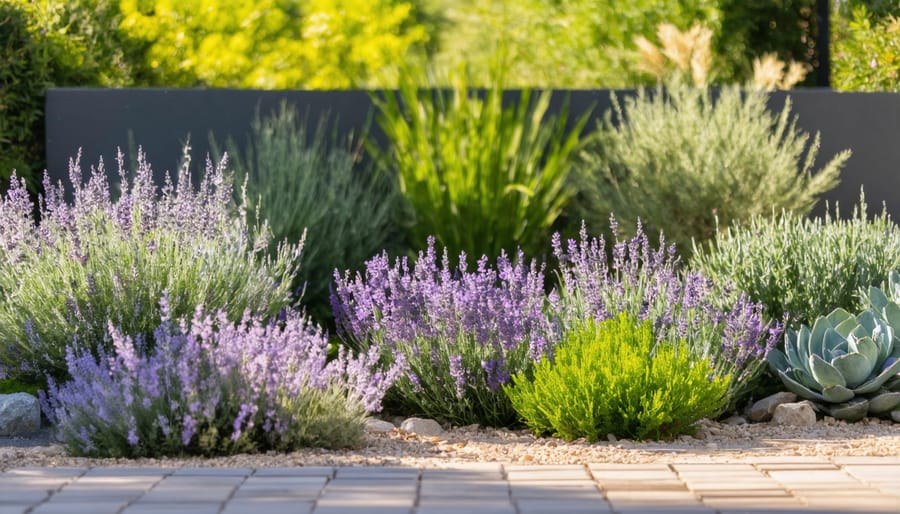
Flood-Resistant Varieties
As climate change brings more frequent flooding events, selecting flood-resistant plants for your garden becomes increasingly important. These resilient varieties have adapted to thrive in wet conditions and can help maintain your garden’s beauty even during challenging times.
Native wetland plants are excellent choices for flood-prone areas. Cardinal flowers, swamp milkweed, and Joe-Pye weed not only survive wet conditions but also attract beneficial pollinators. Iris varieties, particularly Japanese and Louisiana iris, flourish in moist soil and provide stunning blooms throughout the season.
For larger spaces, consider incorporating trees and shrubs that handle periodic flooding well. River birch, red maple, and bald cypress develop extensive root systems that help stabilize soil while tolerating standing water. Buttonbush and elderberry shrubs offer both flood resistance and wildlife benefits.
In vegetable gardens, raised beds can help, but some crops naturally handle wet conditions better than others. Taro, watercress, and certain varieties of kale show remarkable resilience in wet soil. Some berry varieties, like elderberries and cranberries, actually prefer consistently moist conditions.
Remember to group flood-resistant plants together in lower-lying areas of your garden where water naturally collects. This strategic placement creates natural rain gardens that help manage excess water while maintaining an attractive landscape. When selecting plants, always consider your specific climate zone and local rainfall patterns to ensure the best possible outcomes.
Soil Strategies for Climate Resilience
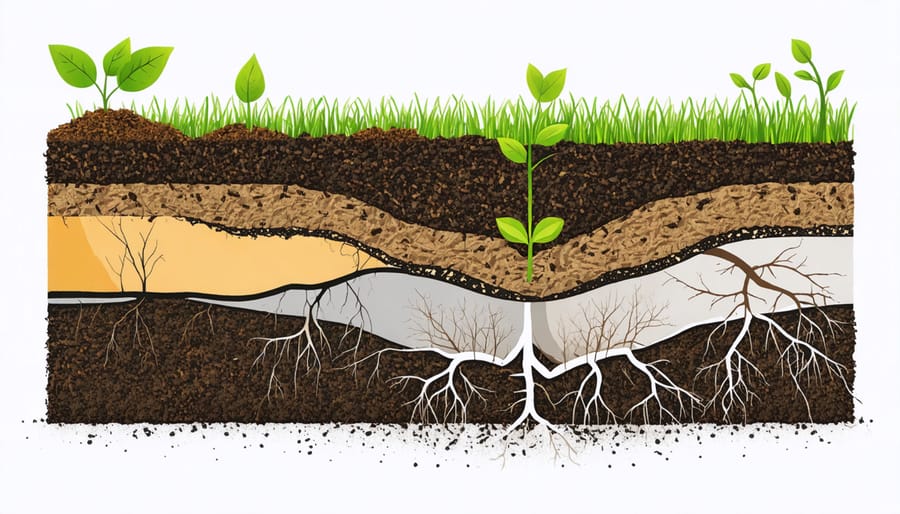
Building Better Soil Structure
A resilient climate garden starts from the ground up, and knowing how to improve soil health is essential for success. Start by adding organic matter like compost, aged manure, or leaf mold to your soil. These materials create a sponge-like structure that helps retain moisture during dry spells while allowing excess water to drain during heavy rains.
Consider incorporating biochar, a carbon-rich material that not only improves soil structure but also helps sequester carbon. Mix in cover crops like clover or rye between growing seasons – their roots create natural channels for water movement and add valuable nutrients when turned into the soil.
For clay-heavy soils, add coarse sand and organic matter to improve drainage. In sandy soils, focus on building up organic content to increase water retention. Remember to avoid walking on your garden beds, as this compacts the soil and reduces its ability to absorb water.
A simple soil test can guide you in adjusting pH levels and nutrient content. Layer mulch around your plants to protect the soil structure you’ve built, reduce water evaporation, and prevent erosion during extreme weather events.
Natural Soil Protection Methods
Protecting your soil naturally is one of the most effective ways to create a climate-resilient garden. Mulching stands out as a garden hero, acting as a protective blanket for your soil. A 2-3 inch layer of organic mulch, such as straw, wood chips, or fallen leaves, helps retain moisture, regulate soil temperature, and prevent erosion during heavy rains.
Ground cover plants serve as living mulch, offering similar benefits while adding beauty to your garden. Low-growing varieties like creeping thyme, sedum, or clover create a dense mat that shields the soil from harsh weather conditions. These plants also help prevent weed growth and provide habitat for beneficial insects.
For slopes and areas prone to erosion, consider planting deep-rooted perennials. Their extensive root systems hold soil in place and improve its structure over time. Native plants are particularly effective as they’re naturally adapted to local conditions.
Remember to avoid leaving soil bare, especially during winter months. If you’re between plantings, consider using cover crops like winter rye or buckwheat. These temporary ground covers protect and enrich your soil, making it more resilient to climate fluctuations while improving its overall health.
Season-Extension Techniques
As unpredictable weather becomes more common, extending your growing season is crucial for maintaining a productive climate garden. Several effective techniques can help protect your plants from extreme conditions while maximizing your harvest throughout the year.
Cold frames are among the most versatile season-extension tools available. These simple structures consist of a transparent lid over a wooden or brick frame, creating a miniature greenhouse effect. They’re perfect for starting seedlings early in spring or protecting cold-hardy vegetables well into winter.
Row covers offer another flexible solution. Made from lightweight fabric or plastic, these protective barriers can be draped directly over plants or supported by hoops. They shield crops from frost, harsh winds, and even certain pests while allowing sunlight, air, and water to reach your plants.
For more permanent protection, consider installing a high tunnel or hoop house. These walk-in structures can extend your growing season by several weeks on either end, providing shelter from both early spring frosts and late autumn chills. They’re particularly effective for heat-loving crops like tomatoes and peppers.
Mulching plays a dual role in season extension. In summer, it helps retain moisture and keep soil temperatures stable. In winter, a thick layer of organic mulch protects root systems from freeze-thaw cycles that can damage or kill plants.
Timing is also crucial. Consider succession planting, where you sow crops every few weeks to ensure continuous harvests. Combine this with careful variety selection – choose both early-maturing and late-season cultivars to spread your harvest window.
Water management becomes especially important when extending the season. Install drip irrigation systems under row covers or in high tunnels to maintain consistent moisture levels without having to disturb protective coverings. Remember to monitor temperature and humidity levels regularly to prevent issues like fungal growth or overheating.
With these techniques in place, you can create a more resilient garden that produces fresh vegetables and herbs well beyond the traditional growing season.
Maintaining Your Climate Garden
Maintaining a climate garden requires year-round attention, but don’t worry – it’s more about working smarter than harder. Start each season with a thorough garden inspection, checking for signs of stress or damage from extreme weather events. During spring and summer, focus on mulching regularly to retain moisture and keep soil temperatures stable. A 2-3 inch layer of organic mulch works wonders for protecting your plants’ root systems.
Water management is crucial throughout the year. Install a rain gauge to monitor precipitation and adjust your watering schedule accordingly. Consider setting up a drip irrigation system with a timer – this helps deliver water directly to plant roots while minimizing waste. During dry spells, water deeply but less frequently to encourage deep root growth.
Pruning is another essential maintenance task. Remove dead or damaged branches promptly to prevent disease spread and maintain plant health. In fall, avoid the temptation to clear away all fallen leaves – some can provide natural mulch and winter protection for beneficial insects.
Monitor your soil health by conducting annual soil tests. Add organic matter like compost throughout the year to improve soil structure and water retention. Remember to rotate your annual crops to prevent soil depletion and reduce pest problems.
Pay special attention to weather forecasts and take preventive measures when extreme conditions are expected. Have frost covers ready for unexpected cold snaps and temporary shade structures for intense heat waves. Keep your garden tools clean and well-maintained, and maintain detailed records of what works well in your specific climate conditions – this information becomes invaluable as your garden evolves with changing weather patterns.
Starting a climate garden is more than just a hobby – it’s a meaningful step toward creating a more resilient and sustainable future. By implementing the principles and techniques we’ve discussed, you’re not only creating a beautiful outdoor space but also contributing to local climate resilience and biodiversity.
Remember that every climate garden journey is unique, and it’s perfectly fine to start small. Begin with a few climate-resistant plants, experiment with water-saving techniques, and gradually expand your garden as you gain confidence. The key is to observe, learn, and adapt your practices based on your local climate conditions and the specific needs of your space.
Don’t be discouraged by initial challenges – gardening is a continuous learning process, and even experienced gardeners face setbacks. Focus on building healthy soil, choosing appropriate plants, and implementing sustainable watering practices. These fundamental elements will set you up for long-term success.
As you develop your climate garden, you’ll likely notice positive changes beyond your garden beds – from increased wildlife activity to reduced water bills and a deeper connection with nature. You might even inspire neighbors to start their own climate-resilient gardens, creating a ripple effect in your community.
Take that first step today. Whether it’s starting a compost pile, installing a rain barrel, or planting your first drought-resistant perennial, every action counts toward creating a more sustainable and climate-resilient future.

